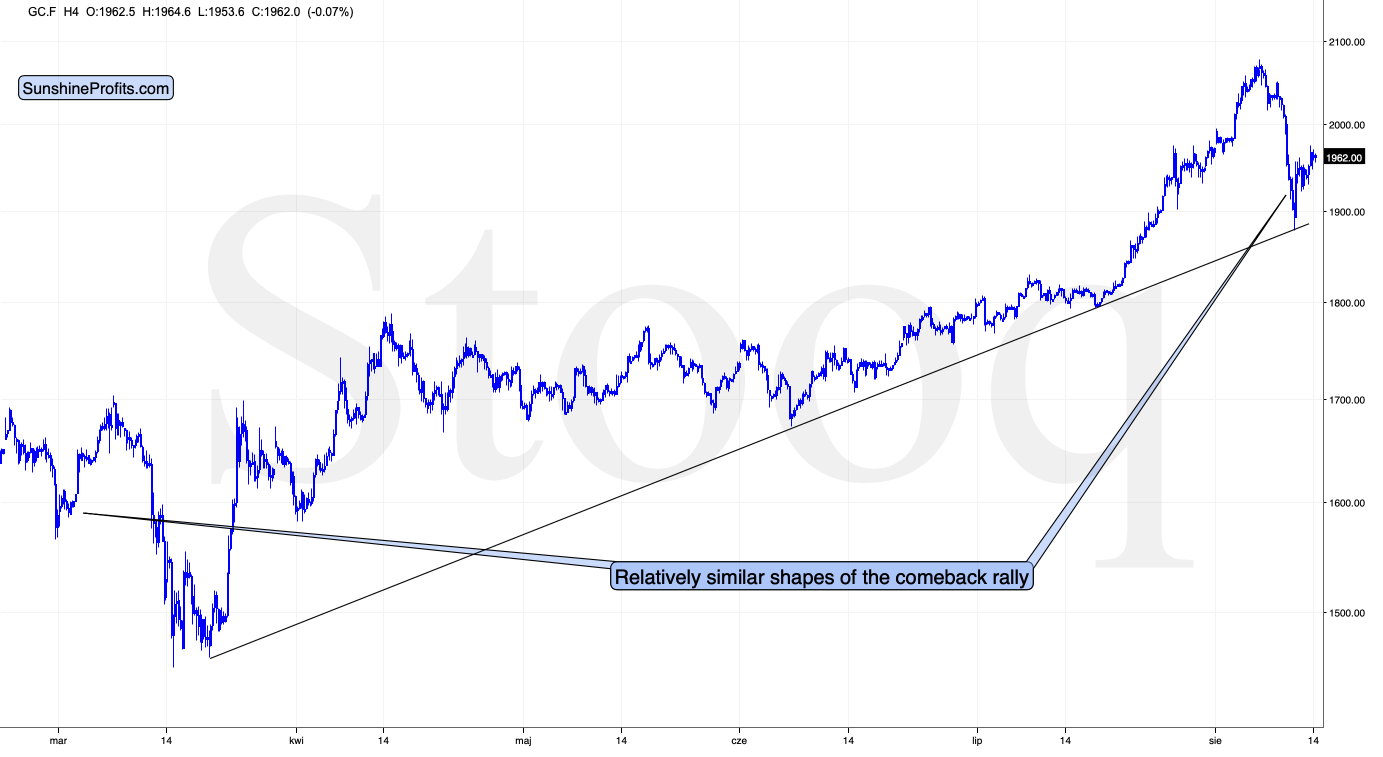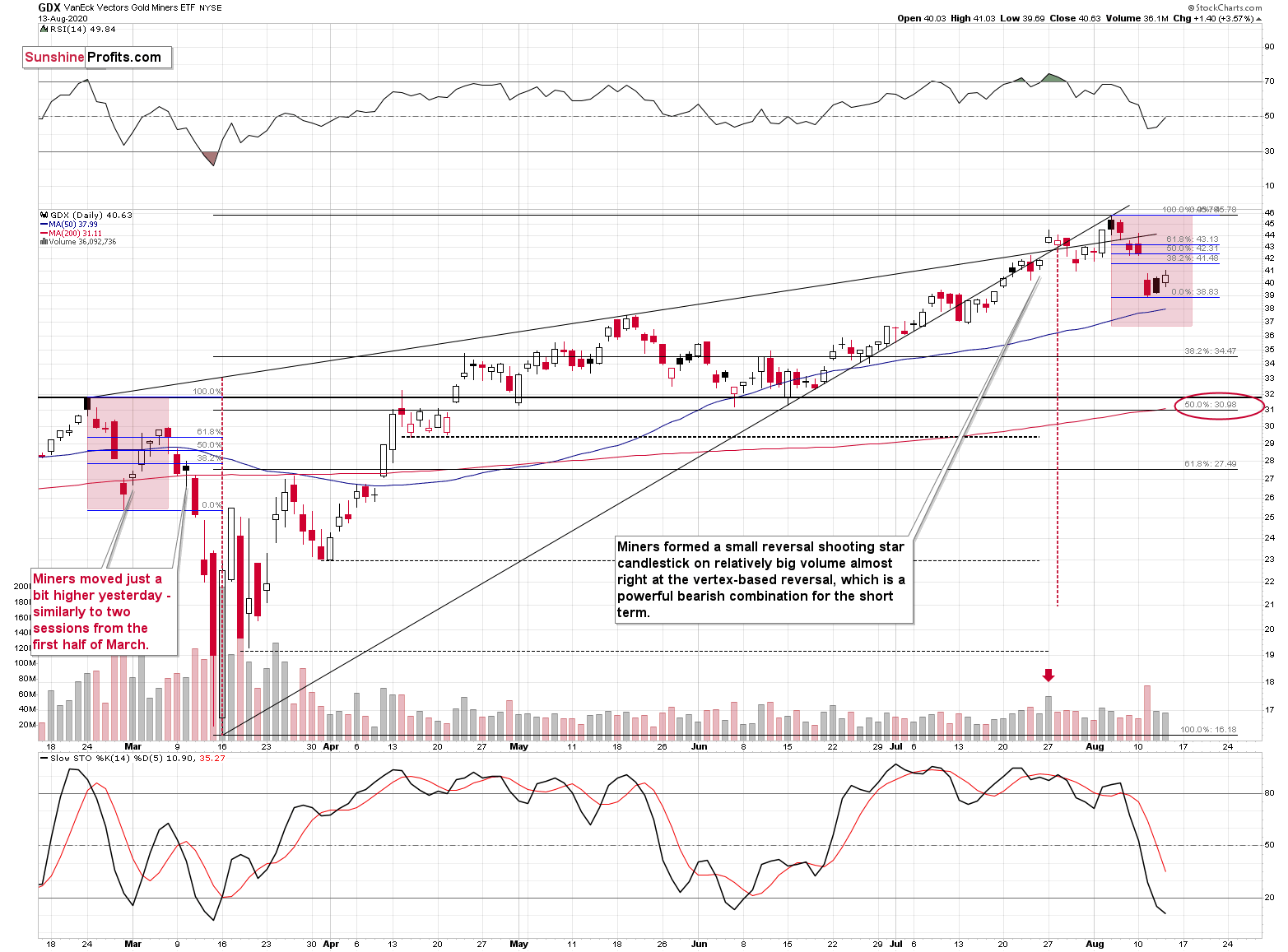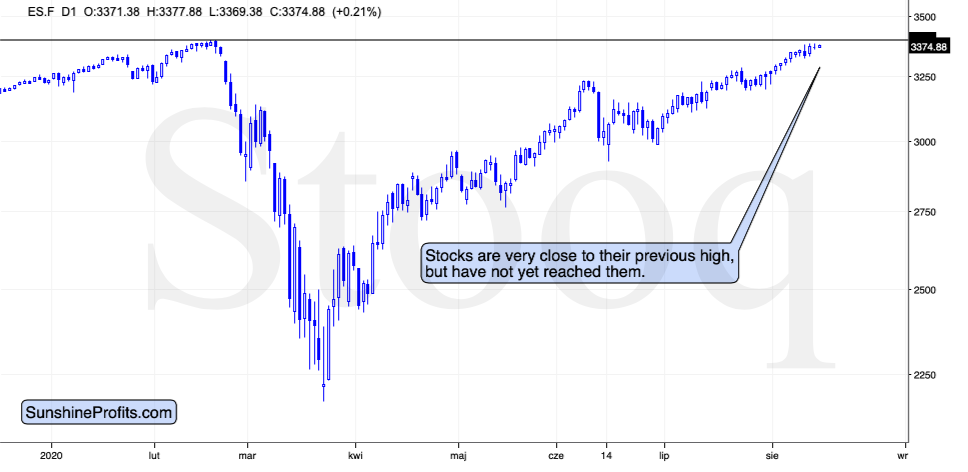Briefly: in our opinion, full (300% of the regular position size) speculative short positions in mining stocks are justified from the risk/reward point of view at the moment of publishing this Alert.
Practically everything that we wrote yesterday and on Wednesday remains up-to-date also today, so if you haven't had the opportunity to read these analyses so far, we encourage you to do so today.
Gold's performance continues to be very similar to what happened in early March and the 4-hour candlestick chart shows the details
Right after the bottom, we saw a sharp - and limited - rebound in both cases: in early March and right now. What happened next in March, was a small decline that was then followed by a sharp rally. We saw more or less the same thing this time, with the difference that the current immediate-term move is not huge. It could easily be the case that this move higher is not big yet, and the similarity-based rally unfolds later today.
The continuation of the pattern would likely lead to a re-test of the previous highs, and perhaps a tiny move above them. Let's keep in mind that it's not only the similarity to the first quarter of this year that suggests this kind of topping pattern, but also the analogy to how gold topped in 2011.
On the above chart, you can also see that the pace at which gold corrected upward before the final (second) top was slightly smaller than the pace at which gold declined from the first top. Consequently, seeing this kind of action right now is not a reason to be concerned.
In case of the GDX ETF, the similarity to what happened in early March is not that visible, but the likely reason is that the above chart features just the trading during the U.S. session. Since the self-similarity in gold is visible when we consider also the overnight price moves, it should be surprising that it's not that visible in GDX. Consequently, it seems that the repeat of the early-March performance is still likely in case of the GDX, even though its chart doesn't really show it.
While gold might move to or slightly above its previous August high, gold miners are not likely to manage to do the same thing. They are likely to underperform, just like did in March, and top below their previous 2020 high.
We previously wrote that the trigger for the big moves in the markets (precious metals, USD Index, commodities) could come from the stock market that might top close to its previous high - perhaps by moving slightly above it and then invalidating the breakout. This remains up-to-date. Stocks are very close to their previous highs, and are consolidating a bit. That's exactly what happened in mid-February before the final top took place and before the big slide started. It seems that the final "go" moment is only a few days away.
We just received a question regarding silver. Precisely: would it be a good idea to bet on silver's decline along with the decline in the miners when gold tops again. In our view, it might be a good idea, but we still think that the best idea is to have a bigger position in the mining stocks initially and then - possibly - to move to a short position in silver after miners already decline very profoundly and silver only "normally".
It could be the case that both markets fall simultaneously (which is likely) and it could be the case that silver declines more than miners. However, the latter is not likely initially. On average, miners tend to move more first, and silver tends to catch up later. In case of shorter price moves, this tends to take little time. For instance, in March, the gains could have been maximized by using miners initially and then - after just a few days - switching to silver.
There's also another benefit of using miners initially - the "what if we're wrong" factor. If gold tops at $2,200 or so (just a random number that's significantly above the recent high), then miners would be likely to not exceed their previous highs in a visible way, but silver would be likely to soar. This means that a short position in miners would probably not move much lower, but a short position in silver likely would.
These are the reasons why we prefer the miners for the time being. Naturally, we're free market guys and we're fine with whatever action one decides to take with their capital.
Overview of the Upcoming Decline
As far as the current overview of the upcoming decline is concerned, I think that after bottoming temporarily at about $1,900, gold, silver and miners will bounce back - perhaps $30-$50 or so in gold - and perhaps back to their previous 2020 highs, and then we will probably see another - bigger - move lower. The latter would likely be triggered by a visible upswing in the USD Index.
During this final part of the slide, we would expect silver to decline more than miners. That would be in tune with how the markets initially reacted to the Covid-19 threat.
The impact of all the new rounds of money printing in the U.S. and Europe on the precious metals prices is very positive in the long run, but it doesn't make the short-term decline unlikely. In the very near term, markets can and do get ahead of themselves and then need to decline - sometimes very profoundly - before continuing their upward march.
We previously wrote that gold might (it was not likely, but we were mentioning this as one of the possibilities) even end its decline at about $1,900, but this is now quite unlikely. The reason is that gold already declined to this level, even though the USD Index's rally didn't really start just yet. So, when the USDX does indeed soar, gold would be likely to decline more.
Summary
Summing up, it seems that after reversing $4 above our upside target, gold has finally topped. The opposite appears likely in store for the USD Index, which seems to have formed a double-bottom pattern. While I can't rule out a situation in which the PMs and miners move higher one final time before plunging (in fact, it's likely in my view), it seems that regardless of this move, the outlook for the next few weeks for the mining stocks is very bearish.
Naturally, everyone's trading is their responsibility, but in our opinion, if there ever was a time to either enter a short position in the miners or to increase its size if it wasn't already sizable, it's now. We made money on the March decline and on the March rebound, and it seems that another massive slide is about to start. When everyone is on one side of the boat, it's a good idea to be on the other side, and the Gold Miners Bullish Percent Index literally indicates that this is the case with mining stocks.
After the sell-off (that takes gold to about $1,700), we expect the precious metals to rally significantly. The final decline might take as little as 1-6 weeks, so it's important to stay alert to any changes.
Most importantly - stay healthy and safe. We made a lot of money on the March decline and the subsequent rebound (its initial part) price moves (and we'll likely make much more in the following weeks and months), but you have to be healthy to really enjoy the results.
As always, we'll keep you - our subscribers - informed.
To summarize:
Trading capital (supplementary part of the portfolio; our opinion): Full speculative short positions (300% of the full position) in mining stocks is justified from the risk to reward point of view with the following binding exit profit-take price levels:
Senior mining stocks (price levels for the GDX ETF): binding profit-take exit price: $32.02; stop-loss: none (the volatility is too big to justify a SL order in case of this particular trade); binding profit-take level for the DUST ETF: $28.73; stop-loss for the DUST ETF: none (the volatility is too big to justify a SL order in case of this particular trade)
Junior mining stocks (price levels for the GDXJ ETF): binding profit-take exit price: $42.72; stop-loss: none (the volatility is too big to justify a SL order in case of this particular trade); binding profit-take level for the JDST ETF: $21.22; stop-loss for the JDST ETF: none (the volatility is too big to justify a SL order in case of this particular trade)
For-your-information targets (our opinion; we continue to think that mining stocks are the preferred way of taking advantage of the upcoming price move, but if for whatever reason one wants / has to use silver or gold for this trade, we are providing the details anyway. In our view, silver has greater potential than gold does):
Silver futures downside profit-take exit price: unclear at this time - initially, it might be a good idea to exit, when gold moves to $1,703.
Gold futures downside profit-take exit price: $1,703
Long-term capital (core part of the portfolio; our opinion): No positions (in other words: cash
Insurance capital (core part of the portfolio; our opinion): Full position
Whether you already subscribed or not, we encourage you to find out how to make the most of our alerts and read our replies to the most common alert-and-gold-trading-related-questions.
Please note that the in the trading section we describe the situation for the day that the alert is posted. In other words, it we are writing about a speculative position, it means that it is up-to-date on the day it was posted. We are also featuring the initial target prices, so that you can decide whether keeping a position on a given day is something that is in tune with your approach (some moves are too small for medium-term traders and some might appear too big for day-traders).
Plus, you might want to read why our stop-loss orders are usually relatively far from the current price.
Please note that a full position doesn't mean using all of the capital for a given trade. You will find details on our thoughts on gold portfolio structuring in the Key Insights section on our website.
As a reminder - "initial target price" means exactly that - an "initial" one, it's not a price level at which we suggest closing positions. If this becomes the case (like it did in the previous trade) we will refer to these levels as levels of exit orders (exactly as we've done previously). Stop-loss levels, however, are naturally not "initial", but something that, in our opinion, might be entered as an order.
Since it is impossible to synchronize target prices and stop-loss levels for all the ETFs and ETNs with the main markets that we provide these levels for (gold, silver and mining stocks - the GDX ETF), the stop-loss levels and target prices for other ETNs and ETF (among other: UGLD, DGLD, USLV, DSLV, NUGT, DUST, JNUG, JDST) are provided as supplementary, and not as "final". This means that if a stop-loss or a target level is reached for any of the "additional instruments" (DGLD for instance), but not for the "main instrument" (gold in this case), we will view positions in both gold and DGLD as still open and the stop-loss for DGLD would have to be moved lower. On the other hand, if gold moves to a stop-loss level but DGLD doesn't, then we will view both positions (in gold and DGLD) as closed. In other words, since it's not possible to be 100% certain that each related instrument moves to a given level when the underlying instrument does, we can't provide levels that would be binding. The levels that we do provide are our best estimate of the levels that will correspond to the levels in the underlying assets, but it will be the underlying assets that one will need to focus on regarding the signs pointing to closing a given position or keeping it open. We might adjust the levels in the "additional instruments" without adjusting the levels in the "main instruments", which will simply mean that we have improved our estimation of these levels, not that we changed our outlook on the markets. We are already working on a tool that would update these levels on a daily basis for the most popular ETFs, ETNs and individual mining stocks.
Our preferred ways to invest in and to trade gold along with the reasoning can be found in the how to buy gold section. Additionally, our preferred ETFs and ETNs can be found in our Gold & Silver ETF Ranking.
As a reminder, Gold & Silver Trading Alerts are posted before or on each trading day (we usually post them before the opening bell, but we don't promise doing that each day). If there's anything urgent, we will send you an additional small alert before posting the main one.
Thank you.
Sincerely,
Przemyslaw Radomski, CFA
Editor-in-chief, Gold & Silver Fund Manager







